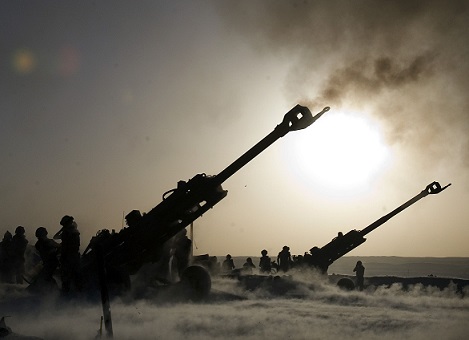
The M-777 howitzers of Indian Army. A file photo
TAWANG, ARUNACHAL PRADESH (PTI): India has deployed upgraded L-70 anti-aircraft guns in the high mountains along the Line of Actual Control (LAC) in Arunachal Pradesh sector in addition to its existing M-777 howitzers and the Swedish Bofors guns, officials said on Wednesday.
The deployment, which came months after the induction of M-777 ultralight howitzers, is aimed at boosting the Indian Army's overall firepower in the face of China's aggressive posturing following the eastern Ladakh standoff, they said.
The upgraded L-70 guns were positioned around two months ago as part of a series of measures taken to bolster the Indian Army's operational preparedness to deal with any eventualities, the officials said.
India has a sizable number of Bofors howitzers in the eastern sector which have been the backbone of its firepower capability in the region.
As part of a high state of preparedness, the Army units including those of the 'integrated defended locality' have been undergoing strenuous physical training and military drills on a daily basis. The 'integrated defended locality' is a specialised unit comprising various arms of the Army including infantry, air defence, and artillery.
Military officials said the upgraded L-70 guns were deployed in several key locations in Arunachal Pradesh in addition to other sensitive positions along the entire LAC and that their inductions have significantly enhanced the Army's air defence mechanism.
"The guns can bring down all unmanned aerial vehicles, unmanned combat aerial vehicles, attack helicopters and modern aircraft. The gun has enhanced target acquisition and automatic target tracking capability under all weather conditions with high-resolution electro-optical sensors comprising a daylight television camera, a thermal imaging camera and a laser-range finder," said Capt. Sariya Abbasi of the Army Air Defence.
"The gun is also equipped with a Muzzle Velocity Radar for enhancing the accuracy of fire. The gun has the ability to be integrated with tactical and fire control radars which give it more flexibility in its deployment," she said.
Capt Abbasi said the legacy gun has now been transformed into a sophisticated air defence gun.
Another official said the upgraded gun system that operates along with a high-end Israeli radar can be counted among the best available air defence guns in its class globally.
In the last few months, the Army has deployed a good number of easily transportable M-777 ultra light howitzer guns which are at times moved from one place to another in Chinook helicopters depending on operational requirement.
The M-777 artillery guns, having a maximum range of 30 km and manufactured by the BAE Systems, were first received by the Army in 2018. The procurement had come after a 30-year wait for new artillery guns since the Bofors scandal.
"The addition of upgraded L-70 air defence guns to the existing Bofors guns and recently inducted M-777 howitzers significantly enhanced the Indian Army's overall operational capability," said a senior official on condition of anonymity.
The L-70 guns were originally manufactured by Swedish defence firm Bofors AB in 1950s and India has started inducting over 1,000 of them in the 1960s.
The guns have been upgraded by state-run Bharat Electronics Limited (BEL).
Following the escalation in tension in eastern Ladakh standoff, the Indian Army has taken a series of measures to boost its operational capabilities in the eastern sector bordering China that included procurement of all terrain vehicles, precision guided ammunition, high-tech surveillance equipment, radars and weapons.
Officials said enhancing combat capability is a continuous process and it will go in sync with operational requirements and overall security situation.
They said an equal amount of focus has been given to enhancing operational capability in the Northern as well as eastern sector.
Eastern Army Commander Lt Gen Manoj Pande on Tuesday said that China has increased the intensity of military exercises and deployment of troops in its depth areas opposite the Arunachal Pradesh sector and that India has correspondingly readied contingency plans to deal with any eventualities.
The commander asserted that the Indian preparedness to respond to any contingency is of a "very high order".
The eastern Ladakh border standoff between the Indian and Chinese militaries erupted on May 5 last year following a violent clash in the Pangong lake areas and both sides gradually enhanced their deployment by rushing in tens of thousands of soldiers as well as heavy weaponry.
The tension escalated following a deadly clash in Galwan Valley on June 15 last year.
As a result of a series of military and diplomatic talks, the two sides completed the disengagement process in the Gogra area in August and in the north and south banks of the Pangong lake in February.
The last round of military talks on October 10 ended in a stalemate following which both sides blamed each other for the impasse.
In a strong statement after the 13th round of talks, the Indian Army said the "constructive suggestions" made by it at the negotiations were neither agreeable to the Chinese side nor could Beijing provide any "forward-looking" proposals.
Each side currently has around 50,000 to 60,000 troops along the Line of Actual Control (LAC) in the sensitive sector.
 Previous Article
Previous Article












The Indian Air Force, in its flight trials evaluation report submitted before the Defence Ministry l..
view articleAn insight into the Medium Multi-Role Combat Aircraft competition...
view articleSky enthusiasts can now spot the International Space Station (ISS) commanded by Indian-American astr..
view article